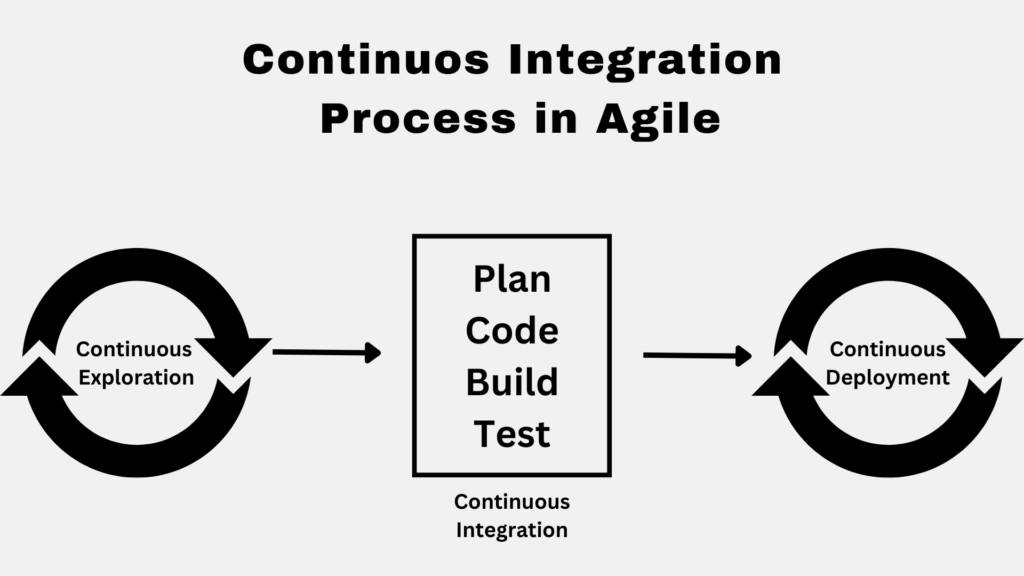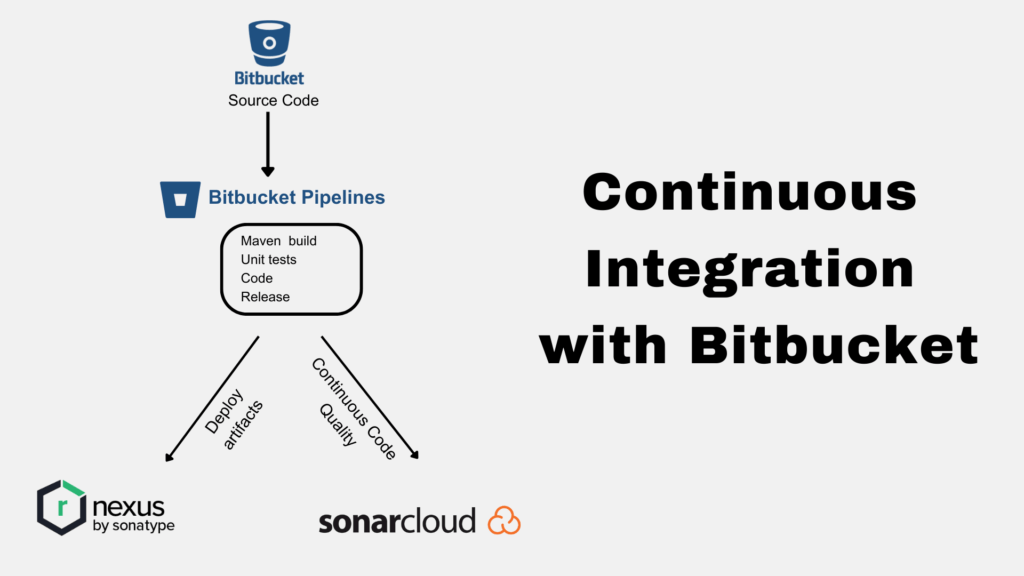CI is crucial in modern AI-powered software development, ensuring efficient, high-quality, and timely delivery. Moreover, it involves frequently integrating code changes into a shared repository and automating build and testing processes to identify integration issues. In this article, we’ll delve into its principles by continuous integration with Bitbucket. Furthermore, we’ll also investigate how it contributes to smooth continuous integration, delivery, and deployment processes in an agile environment. Additionally, we will also mention the continuous integration build tools and explore the continuous integration free tools for effortless integration. Consequently, we will investigate the integration of AI to enhance the optimization of its procedures.
Continuous Integration Principles
The continuous integration principles underscore the necessity of frequent code integration, paired with automated testing for the identification of integration issues. As a result, developers execute numerous daily code commits to a shared repository, triggering an automated suite for validating alterations. This iterative approach significantly diminishes integration challenges, particularly when numerous developers collaborate on the same codebase. Moreover, besides streamlining development, it cultivates a collaborative, accountable environment in the team, fortifying a more robust, reliable codebase. In this context, AI plays a pivotal role in automating and improving testing, enhancing accuracy and efficiency in identifying integration issues.
Continuous Integration Process in Agile

In agile methodologies, CI is pivotal for realizing agile principles, aligning seamlessly with iterative and incremental development. It enables the smooth integration of small, frequent updates into the codebase, fostering collaboration among diverse cross-functional teams. Swift feedback loops propel product enhancement in this collaborative environment. Continuous integration ensures that product improvements align with evolving requirements, maintaining a competitive edge in the dynamic software development landscape. This iterative and collaborative workflow is foundational to achieving agility and delivering high-quality, market-ready products. Notably, AI technologies increasingly enhance collaboration and feedback loops in agile processes, aiding quicker decision-making and more efficient workflows.
Continuous Integration with Bitbucket

Bitbucket is a web-based Git repository hosting service. Additionally, it offers a robust platform for version control, code collaboration, and seamless integration, serving project hosting needs. Bitbucket Pipelines is a built-in CI/CD service seamlessly integrated with Bitbucket Cloud. Widely embraced as a Git repository management solution, Bitbucket particularly excels in enabling effective continuous integration. Developers find it easy to configure continuous integration pipelines within Bitbucket, builds, tests, and predefined actions for every code commit. This integration greatly streamlines the development process, fostering collaboration and ensuring a continuous flow of changes in the codebase. Furthermore, AI’s continuous integration with Bitbucket takes automation a step further, optimizing build and test execution. It results in quicker and more precise outcomes.
Continuous Integration, Continuous Delivery, and Continuous Deployment:
Continuous Integration, Delivery, and Deployment collectively establish the cornerstone of the CI/CD pipeline. Code Integration is initiated by Continuous Integration. In addition, Continuous Delivery automates the release process, ensuring software is deployment-ready at any juncture. Furthermore, Continuous Deployment takes it further by automatically deploying validated alterations into the production environment. This strategic triad propels the software lifecycle, balancing rapid delivery with precise development. Notably, AI is increasingly integrated into the CD process, optimizing deployment for a seamless transition from development to production. This integration of AI holds great promise in streamlining and automating CI/CD pipelines, enhancing efficiency, and facilitating high-quality software delivery.
Continuous Integration Build Tools
Multiple continuous integration build tools streamline the automation of building, testing, and integration processes.
Moreover, GitLab CI and CircleCI, major players, offer flexible features to align the CI process with organizations’ unique development requirements. Furthermore, AI’s integration into these tools improves build configurations with intelligent recommendations, ultimately enhancing the efficiency of the build process. Additionally, AI integration in build tools promises faster software development, precise continuous integration, and improved delivery of high-quality products. Consequently, the continuous advancement in AI will likely redefine the landscape of CI/CD tools, revolutionizing software development processes.
Continuous Integration Free Tools
In budget-constrained environments, various continuous integration-free tools are accessible. For instance, Jenkins, an open-source automation server, stands out for its extensibility and community support. Additionally, Travis CI is another valuable choice, offering free plans for open-source projects, enabling automated builds and tests without financial burden. Notably, AI integration is increasingly incorporated into these free tools, amplifying automation and intelligence in managing CI processes. This enhancement empowers free tools, offering cost-effective, efficient, and smart solutions, aiding developers in delivering quality software. Consequently, the integration of AI promises an impactful role in revolutionizing CI processes within resource constraints.
Roles and Responsibilities in Continuous Integration
1. Developers Responsibilities
Developers are responsible for frequent code commits and creating automated tests to validate changes. Moreover, they are also responsible for promptly addressing any integration errors in the shared repository.
2. CI/CD Engineers Responsibilities
CI/CD Engineers are responsible for configuring CI/CD pipelines using suitable tools for seamless integration and deployment. Additionally, they optimize appropriate tools for efficient integration and deployment processes.
3. Quality Assurance (QA) Team Responsibilities
The QA team’s duties include maintaining a robust set of automated tests and ensuring integrated code meets established quality benchmarks. Furthermore, they collaborate with developers to enhance test efficiency.
4. DevOps Team Responsibilities
The DevOps team automates deployment, integrates processes, and manages infrastructure to align with the CI/CD pipeline. Moreover. they collaborate for an efficient software delivery lifecycle.
The Road Ahead
The road ahead for continuous integration is exciting and promising. The future of software development is rapidly evolving; CI will remain a cornerstone in this dynamic landscape. As technology progresses, and methodologies like agile and DevOps gain traction, seamless integration, efficient testing, and prompt feedback are vital. Moreover, integrating emerging technologies like machine learning and AI into CI is expected to revolutionize testing and enhance software delivery. Consequently, AI will continue to play a pivotal role in optimizing CI processes, predicting integration issues, and suggesting improvements for an even more efficient workflow.
Final Thoughts
In conclusion, organizations must stay current with trends, tools, and methodologies to remain competitive and deliver software efficiently. Moreover, keeping up-to-date is essential for success. Integrating it into the software development process is vital for attaining this objective. Furthermore, teams can easily integrate code changes, identify integration issues early, and maintain a codebase by using the right tools. This approach ensures a dependable and resilient foundation for software development. Additionally, understanding its process ensures effective collaboration and the successful implementation of CI practices in agile development. Consequently, AI will continue to evolve and deeply integrate within the CI landscape, offering enhanced automation and intelligent decision-making capabilities.

